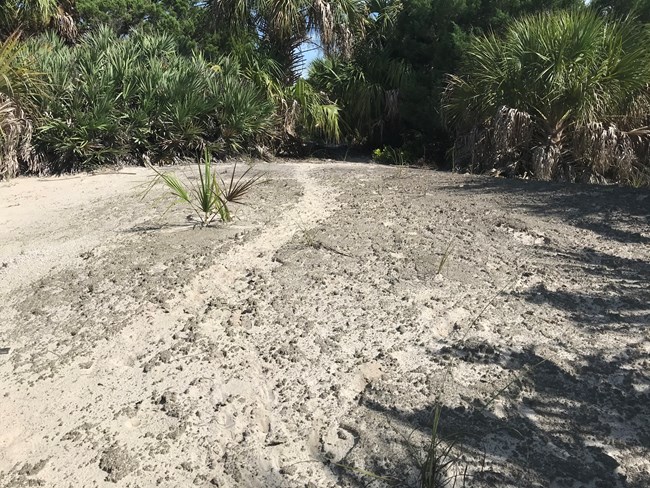
Soil can be defined as the loose top layer of the Earth’s crust consisting of rock and mineral particles mixed with decayed organic matter (known as humus). At Fort Matanzas, soil can be generally divided into two types: sandy soils and mucky marsh soils. (The park consists of portions of two barrier islands surrounded by ocean and estuary, so these types of soils are likely to predominate.) But soils can be subdivided even further depending on their specific characteristics, and as in every national park, varieties of soils are considered natural resources that are protected for the role they play in contributing to the overall ecosystem. The “soil” most people seem to appreciate and enjoy at Fort Matanzas is the open beach. It is composed of primarily two different types of sand: a whiteish quartz sand and an orangish shelly sand. Quartz is a major component of granite, and is itself composed of oxygen and silicon atoms combined into a mineral known as silicon dioxide. As granitic mountains erode over the eons, quartz is washed down to the sea by rivers and is eventually redeposited along the shorelines as beach sand. The orangey sand, on the other hand, is a hash made up of broken down shell particles, including large amounts of a tiny local clam known as coquina. Since there are offshore lenses of compacted coquina near the Matanzas Inlet, the inlet area is where the orange sand predominates. The dunes and scrub habitat are underlain by a fine sand with more of an organic component and supports sand live oak, saw palmetto, and native grasses and wildflowers. The soil of the hardwood hammock (mature coastal forest) is even richer with decayed plant matter and features large plant species like sabal palm, yaupon holly, and live oak. The barrier island upon which the fort itself sits is protected from the open ocean by an estuary and the other barrier island. Accordingly, the majority of this island’s soil, while still predominately sandy, contains a clayey substratum due to its proximity to marshlands. (The northernmost end of the island was supplemented with dredge material from the Intracoastal Waterway for many years proceeding its addition to the park, and its soils contain much less clay material.) Finally, the low salt marsh habitat existing in the park receives both salt and fresh water from the Matanzas River estuary and supports a plant community that is transitional between the dry uplands and the open water. Its soil is a frequently flooded silty clay loam. (Loam is sand mixed with large and varying percentages of silt and clay.) It also includes a huge organic component called detritus, which is the partially decomposed remains of the thick cover of plant material (largely cordgrasses and rushes) that dies and falls to the marsh floor over time. So, far from being taken for granted, maybe the next time we’re walking in a natural area, we should look down and admire the earth beneath our feet for the amazing natural resource it is! |
Last updated: January 19, 2021
